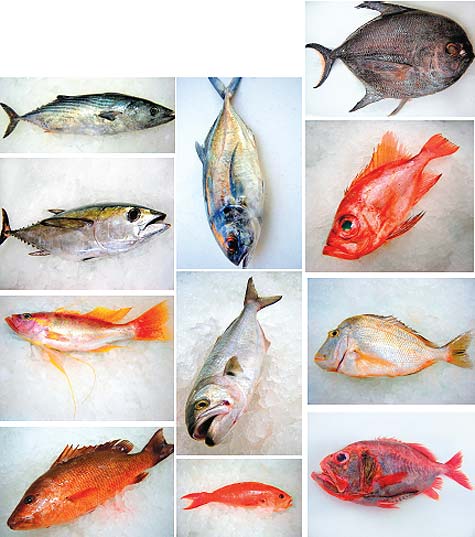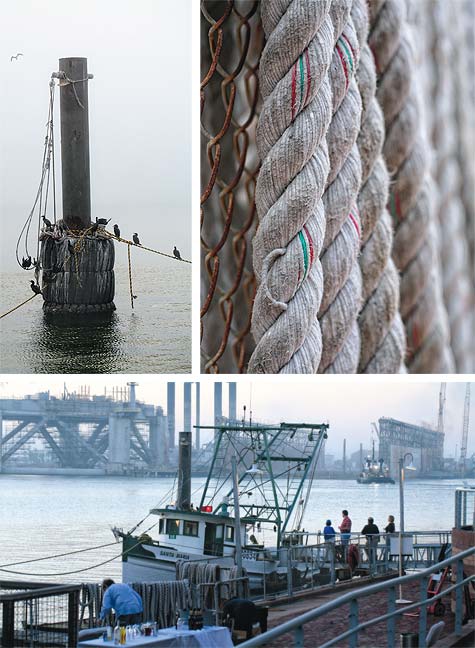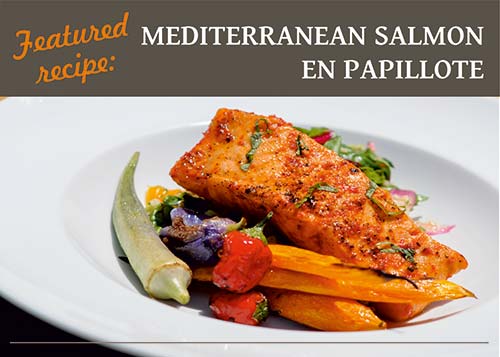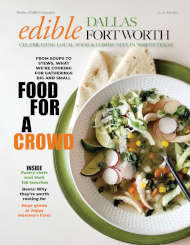
Photo courtesy of PJ Stoops
Photos by Kelly Yandell
I am a fishing kid. Or rather, I am a 40-year-old version of a fishing kid.
My mother and father were both raised fishing, and they raised my brother and me to fish, as well. I knew how to pull out a backlash on a casting reel before I turned seven. I knew as a mere toddler that at 6:30 a.m., a Texas lake is prettier than almost any spot on earth. But my decent vocabulary of freshwater game fish, the various bass, crappie, catfish, and bream to name a few, belies my landlocked ignorance. I have traveled to the Gulf to take my own children to the beach, but never ventured to think about what was swimming in the water other than people and jellyfish. As a cook, I have rarely given a thought to where my saltwater fish comes from prior to gazing at it through the glass, lined up in neat little boneless, mostly skinless rows. A recent trip to the Gulf Coast changed my outlook completely.
In February, I attended my first Foodways Texas event in Galveston. Foodways Texas is a celebratory, academic, nonprofit organization with a goal of documenting the historical food cultures of Texas. It also hosts symposia that allow Texas food communities to discuss current topics of interest. At the Galveston gathering, the discussion that really caught my attention was the one on trashfish and bycatch led by fishmonger PJ Stoops of Louisiana Foods, Chef Bryan Caswell of Reef in Houston and Chef Jesse Griffiths of Dai Due Supper Club in Austin.
Trashfish and bycatch are highly ironic monikers that relate to how a species of edible fish has been treated commercially. It is an assessment of economy, not gastronomy. When commercial fishing boats enter the Gulf, they each have a goal, or a “target” species.
They are looking for a haul of snapper or shrimp or whatever species they are able to most successfully market. As the lines and nets are brought in, numerous other species of fish are pulled in with the target species. This is bycatch. With no readily available market for these varieties, they are considered trash and thrown back. Sadly, many are already dead or significantly injured at this point.
Trashfish doesn’t sound very appetizing, but certain experts, like Stoops, Caswell and Griffiths, are convinced that this is the new wave of ethical and sustainable seafood consumption. The only requirement is that we consumers have to learn a bit and look past the marquee fish of which we have been so enamored for the past two decades. Amongst them–the swordfish, the legendary bluefin tuna and the true red snapper–swim hordes of little known and altogether ignored species that are plentiful, delicious and basically wasted. These are fish that are highly valued in foreign markets, and some are considered true delicacies.
Technology and improved methods have made it easier, relative to 100 years ago, to harvest massive quantities of not only shrimp, but the highly sought after apex predator species. These are the species at the top of the food chain. The over-harvesting of these large fish with long reproduction cycles is fraught with risk to each of these species. Where fishermen once boasted of reeling in 2000-pound swordfish, they now routinely catch 200-pounders. The old ones are increasingly gone, and the young fish cannot develop into adulthood before being caught. These converging issues make the acceptance of and education about the alternative species in the Gulf all the more important.
It is easy, upon first glimpse of this issue to immediately point a finger at commercial fishermen for these phenomena. But, ever since we heard about dolphin getting caught in tuna nets, great strides have been made in creating fishing technology that minimizes bycatch. Fishermen bring to dock that which they can sell. We, the consumers, are the ones who create the demand. If we demand big slabs of boneless fish and are willing to pay dearly for it, we will be sold just that. If we gravitate to the exact same “popular” fish each time we order at a restaurant, that is what we will be served. However, if we ask our fishmonger or chefs to educate us about other types of smaller, less known fare, perhaps we too can take part in a new way of looking at Gulf seafood. Expanding our palates and celebrating the Gulf will have the consequence of taking pressures off of the arguably overharvested fisheries and help open a viable market for the species we now refer to as only bycatch and trashfish.
An exciting Saturday market in Houston aims to change the way we look at Gulf seafood. Louisiana Foods is a large Houstonbased seafood distributor. Its founder, Jim Gossen, is a true advocate of Gulf Coast seafood and the health of its fisheries. He gave Stoops and Billy Tellez the green light to start the Total Catch Market. For years, Stoops had been trying to convince boat captains that they would not be “wasting ice” by keeping the bycatch. Time spent working in kitchens in France and Thailand had given him a window on the exceptionally diverse palates in other countries. He took his curiosity about the Gulf and his culinary awareness and started trying to source and market new and interesting fish to chefs. The result, several years since he began in earnest, has been the vibrant, new Saturday market at Louisiana Foods. Using social media such as Twitter and the Total Catch Market website, Stoops puts out the word to his customers. He produces a weekly list of the bycatch being brought in for the Saturday markets, and he is on hand to educate his customers about filleting and deboning the fish, if needed, and cooking ideas.
The given names of these fish are colloquial delights – sheepshead, barrelfish, spinycheek scorpionfish, tilefish, pink porgy, triggerfish. The diversity of the offerings is a dream for any adventurous cook. But the real lesson of bycatch is that we have a backyard overflowing with obtainable, ample, healthful and beautiful food about which those outside the commercial and recreational fishing industries know virtually nothing. Ironically, several of these fish are only considered “trash” in our specific part of the Gulf. In the eastern Gulf, triggerfish, tilefish and pink porgy are targeted, and the pink porgy has even been overfished in the south Atlantic fisheries.
Houstonians of various cultural backgrounds are excited that they now have access to fish that they haven’t been able to source since they lived in their native countries. “In the Mediterranean, the spinycheek scorpionfish is considered a requirement for bouillabaisse,” said Stoops. “Here, you normally can’t get it.” Several customers have asked to be immediately alerted any time the scorpionfish is available. And, while the aptly named Total Catch Market does not restrict its market to only the Gulf fish and bycatch, Stoops has been excited to see that every Saturday the local fish is what went first.
At the Foodways symposium, Chef Tim Byres of Smoke, a Dallas restaurant devoted to sustainability, teamed up with Louisiana Foods to create a meal from a bycatch species for attendees. As the fog rolled over a cool Galveston evening, Byres stood over a bed of glowing orange coals and prepared an elegant meal of grilled black drum. It was a substantial, meaty, and satisfying fish. He served it with a traditional boiled shrimp and a decidedly non-traditional ash salsa made from chiles charred on the coals.
What Stoops knows, and what Byres showed us that evening, is that chefs and local fish shops will be the vanguard of widespread acceptability of bycatch and trashfish. When a respected chef introduces us to a new type of fish and shows us that it can be prepared well, we then turn around and try to achieve those results in our own homes.
There is no better regional example of chef-driven food acceptance than Paul Prudhomme and the popularity he brought to the redfish. Gossen recently asked Prudhomme why he chose the redfish. Prudhomme related to him that it was good, and it was available. Prior to Prudhomme starting a veritable craze over blackened redfish, it was not used much commercially. The irony of the notion of bycatch is that once we see the value in these fish and help create a viable market for them, they become a valuable target species. Now, due to incredible response of diners, the redfish has game-fish status and is protected.
However, the total-catch concept is more attractive because it focuses on the emergence of a whole array of species and not just one. As “total catch” implies, we need not restrict our palates to achieve this, but merely expand them. That is a win-win proposition for anyone who loves seafood.
This new way of looking at Gulf seafood is making its way to our area. Jon Alexis of TJ’s Fresh Seafood Market is determined to bring bycatch to Dallas, and he thinks home cooks are more than up to this challenge. “One of the big misconceptions about seafood is that each species requires unique cooking instructions or recipes,” says Alexis. “Most every fish filet can be cooked with similar preparations.”
As stories abound about food safety and the unknowable provenance of some of the fish that comes to market, the idea of getting our fish from our own local waters becomes all the more attractive. It is also a matter of jobs, economy, safety, and good old-fashioned local eating. This move to utilize these excellent Gulf resources is locavorism in the name of an exceptional product. We will always have our favorite non-locally sourced fish, but it is time that we celebrate what we already have. As a cook, I am excited and challenged, and I will never look into the fish case at my local market the same way again.
Total Catch Market: totalcatchmarket.blogspot.com
Foodways Texas: foodwaystexas.com
Smoke: smokerestaurant.com
TJ’s Fresh Seafood Market: tjsseafood.com
RECIPE IDEAS FOR YOUR BYCATCH
These recipes by Chef Tim Byres of SMOKE restaurant in Dallas can be enjoyed individually, but when plated together, they’re divine. For an added bit of color and layers of flavor, spoon Roasted Ash Salsa Negro over the Grilled Black Drum, then top with a layer of Pico de Gallo. Serve the Blistered Tomatoes and Pickled Vegetables on a pool of Tomatillo Salsa Verde. Chef Byres’ resume includes stints with Stephan Pyles, the Mansion at Turtle Creek and the U.S. Embassy in Brussels. He was recently named Food and Wine magazine’s “The People’s Best New Chef” for the Southwest region.
BLISTERED TOMATOES WITH PICKLED
GREEN BEANS AND CARROTS

KELLY YANDELL is a writer and photographer based in Dallas. She has contributed to Edible Dallas & Fort Worth since 2011. Her website (themeaningofpie.com) celebrates practical dishes and comfort foods, while her photography portfolio can be found at kellyyandell.com. Kelly is an attorney and is the vice president of the Advisory Board of Foodways Texas, an organization founded by scholars, chefs, journalists, restaurateurs, farmers, ranchers, and other citizens of the state of Texas who have made it their mission to preserve, promote and celebrate the diverse food cultures of Texas.











